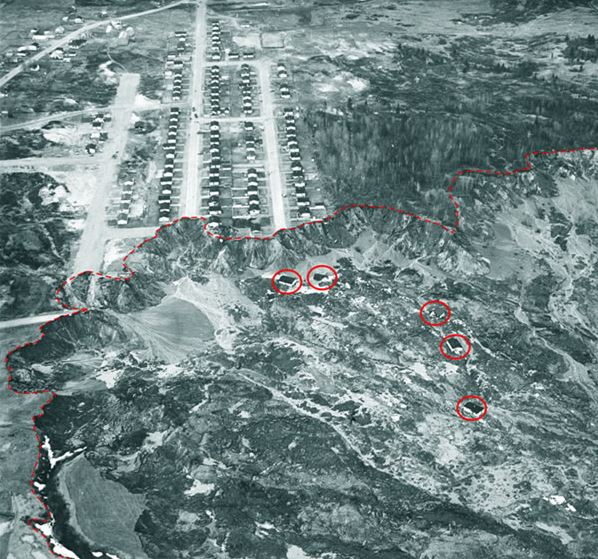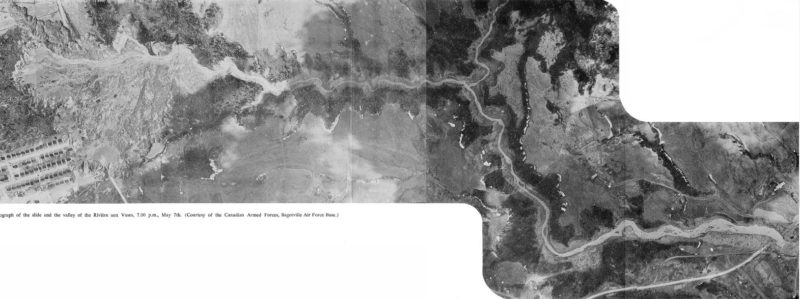19 March 2020
The May 1971 Saint Jean Vianney landslide disaster
Posted by Dave Petley
The May 1971 Saint Jean Vianney landslide disaster
One of my daily landslide feeds threw up an interesting reflection today on the May 1971 Saint Jean Vianney landslide disaster in Quebec, Canada. This landslide, which occurred with little warning at 10:15 pm on 4 May 1971, affected the eastern side of the town, destroying 40 homes and killing 30 people. This extraordinary image, taken in the aftermath of the landslide, shows the scale of the failure. Note the houses lying within the landslide mass:-

The aftermath of the 1971 St. Jean Vianney landslide in Canada. Image published by Gendisasters.
.
There are many resources about this landslide available online, and the landslide was described in an article published in the Canadian Geotechnical Journal (Tavenas et al. 1971). The landslide occurred in the Champlain Clay, now known to be a classic sensitive or quick clay. Such materials can generate spectacular retrogressive landslides – I have featured a number of more recent examples on this blog.
This was an enormous landslide – Tavenas et al. (1971) give a volume of 6.9 million cubic metres – and the image below from the paper provides an overview of the full extent of the slide:-

Vertical aerial image of the Saint Jean Vianney landslide, from Tavernas et al. (1971)
.
The likely cause of the landslide was a spell of warmer weather, which drove a thaw, followed by two spells of heavy rainfall, one in late April and the second on 3-4 May 1971. On 24 April a smaller landslide occurred on the periphery of what became the main landslide a few days later.
Tavernas et al. (1971) used eye-witness reports to try to reconstruct the sequence of events for the Saint Jean Vianney landslide. This provides a fascinating set of accounts, starting with this one:
Mr. R. Girard and Mr. J. Tremblay, living in the new development of Saint-Jean-Vianney, reported that their dogs started to behave abnormally at 7.00 p.m. on May 4th, being extremely nervous. Mr. Girard described the behavior of his dog as the same as during a thunderstorm.
From this, and other accounts, Tavernas et al. (1971) proposed that instability started at about 7 pm, with the first major failure occurring at about 10:15 pm. Over the next 45 minutes the landslide appears to have undergone a series of retrogressive events; by 11pm most of the houses that were lost had been destroyed.
There are many harrowing stories from survivors of this landslide, The Montreal Gazette article includes two such accounts:
Resident François Richard told our reporter he was in his living room watching the hockey game when he heard shouting outside. “He walked 600 metres down his street and saw houses falling one by one.”
One lucky woman survived by crawling onto the roof of her car after it had fallen into the crater. But there were few such stories. Many families were trapped in the liquid mud, which then solidified.
This event greatly increased awareness of the hazards posed by sensitive clays, although sadly such failures continue to occur occasionally, especially in Norway, Sweden and Canada.
Reference
Tavenas, F., Chagnon, J-Y., and La Rochelle, P. 1971. The Saint-Jean-Vianney Landslide: Observations and Eyewitnesses Accounts. Canadian Geotechnical Journal, 8, 463-478, https://doi.org/10.1139


 Dave Petley is the Vice-Chancellor of the University of Hull in the United Kingdom. His blog provides commentary and analysis of landslide events occurring worldwide, including the landslides themselves, latest research, and conferences and meetings.
Dave Petley is the Vice-Chancellor of the University of Hull in the United Kingdom. His blog provides commentary and analysis of landslide events occurring worldwide, including the landslides themselves, latest research, and conferences and meetings.
Very interesting. An indication of the way in which quick clay slides develop can be seen from the video of the Rissa landslide in 1978 produced by the Norwegian Geotechnical Institute. It is available on YouTube.
I heard about this event a lot when I was young, but these days I can’t help but think about it constantly. I’m always scared of it happening again. I about live 10 minutes from Saint-Jean-Vianney and over the last few years our land has had two landslides closer than 50 meters to the house, the last of which was quite big, maybe 20 meters long. The other day I was driving my boat on the river, and I counted no less than 10 landslides, and that without moving, just staying at the same place.
All of it is quite disturbing really. But it’s good to know where that kind of phenomenon happens! I don’t feel more at ease though xD
Please MOVE!!!